On March 15th the Copley Society of Boston opened its annual spring exhibition, with a wonderful collection of the works of this great master of Impression- ism. The Copley Society has been cutting a wide swath in the field of art during the past few years. It has kept steadily before it the highest standards as a beacon-light to guide its action. No collection of paintings has been too good for its walls and the public. It has not been content to sit idle and ap- plaud others, but has taken upon its shoulders great burdens of responsibility and trouble; out of these have sprung recently, like the harvest from the seed, the Sargent and the Whis- tler exhibitions, which have caused the pattering of many feet towards the Hub. In fact, strange as it may appear, art in Boston, at least the collecting of fine pictures and the exhibiting of them with enthusiasm from the love of art, is not at as white a heat as it might be, and it is fortunate that the leaven of the Copley Society is of the lively kind, which acts as a leaven for the lump. Is it at all to be wondered at that people flock to Copley Hall, one of the finest places in the world for good pictures, to get fresh, vigorous draughts of inspiration? Claude Monet will probably always be regarded as the great leader in that modern and latest phase of art known as Impressionism, although he is by no means the dean of the school. Pissarro was born in 1830, while Monet did not sec the light of day until ten years later, but Monet is by far the greatest producer in his school, and his works are of a range in subject which stamp him as a man of
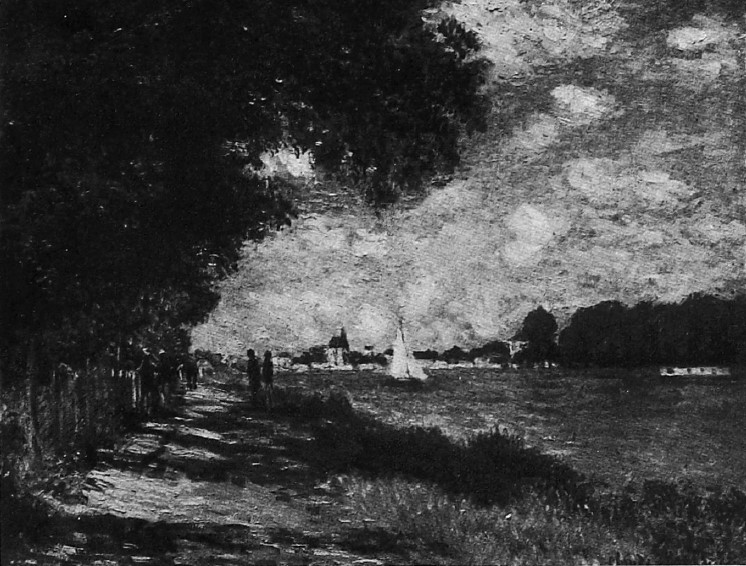
ARGENTEUIL
real genius, and the best kind of genius, because it is the genius of patient and continuous study and improvement. In other words, Monet has somewhere in his head a wonderful balance-wheel. The writer will never forget the day he spent with him in Giverny. It was in 1900. It was a last day in Paris, and arrange- ments had been made to fill the time with several delightful engage- ments, among them a visit to a collection of Japanese pictures, but it was all thrown to the wind when a note arrived from Monet, sug- gesting a lunch with him at Giverny, and adding that he would send a carriage to the railroad station at Vernon. On that drive to Giverny the scenes made forever famous by the works of the master were recognized on every hand, as the carriage rolled on its journey through pink-tinted landscapes. The greeting was offered by a sturdy, quiet man, well past middle life, with a decided English appearance, which was emphasized by a long, flowing beard, sprinkled with silver threads, adding to the delusion. There was a slight dis- tinction in his dress, a soft ruffled shirt with ruffled wristbands instead of the conventional stiff starchings of ordinary garb. The trousers were buttoned closely to the leg from the knee to the ankle. There

GARE ST. LAZARE-EFFET DE SOLEIL
was no waistcoat to smother the soft ruffled shirt. A well-developed physique seemed to challenge the beholder to produce a better. Such were the writer’s first impressions of the great master of the pleirt-air school. His house looks out upon a charming garden, the pride of the artist. Here he has lovingly nurtured many beautiful flowers, and painted many beautiful canvases. The little arched bridge across an affluent of the Epte was visible at the lower end of the garden, a feature introduced into a number of studies of a Japanese water- garden. A spacious detached building or studio in this garden con- tains many of the artist’s pictures. The walls were well covered, and the eye feasted on the counterfeits of nature from Belle-Isle to Water- loo Bridge. In this room were first seen a number of pictures in various stages of completion of what is now known as the “Thames Series,’’ and this brings us to a few words in regard to some of our artist’s subjects. The majority of artists develop a distinct fondness for some special subject, such as marines, animals, still-life, interiors of forests, such as Diaz painted for instance, with the result that there is a very close similarity in the canvases. Not so, however, with Monet.
At one moment he is in the mountains and thoroughly absorbed in the grand and somber carvings of the hills, and brings back to the world a series of pictures known as the “Creuze Series,’’ majestic with the solemn beauty of the mountains and torrents. There is to-day, by the by, not a single example of these eleven pictures in France. They are all owned outside of Monet’s own country. The writer had the pleasure of seeing the greater part of them hanging together in a group by themselves in the Monet exhibition in Paris in 1889. At another period of his life we find him devoted to the study of hay-stacks, which challenged his admiration by the variety and deli- cacy of their coloring under different lighting. As a result we have the “Hay-Stack Series,’’ symphonies of rose and purple, painted in 1891 or thereabouts, and of which there are perhaps twenty examples in existence. A little later we have the “Poplar Series,’’ exhibited in 1892. The “Matinee Series’’ were delicate morning studies of landscape effects in the vicinity of the Seine; there are perhaps ten examples.

LES DECHARGEURS DE CHARBON
The “Cathedral Series’’ is as widely known as any of Monet’s works, and they are truly remarkable creations. Personally the writer has not the same affection for them as for the shimmering lights in those charming, ever-changing landscape effects, which have appeared from his brush in prolific numbers during the last thirty years. Monet says, in a letter to a friend, that he painted the Rouen Cathedral “in great discomfort, looking out of a shop window oppo- site the cathedral, so there is nothing interesting to tell you except the immense difficulty of the task which took me three years to accomplish.’’ This shop was on the southwest side of the “Place,” and it was a little curiosity shop boasting the title “Au Caprice.” There were originally about twenty-five of the “Cathedral Series,” but as the artist added several afterwards, there are now possibly thirty-five in existence. Within the last few years we have the “Thames Series.” In 1870, when Monet was quite a young man, he visited London, and there met Bonvin and Pissarro, also Daubigny, who was painting scenes on the Thames. It was Daubigny, who told Durand-Ruel, at
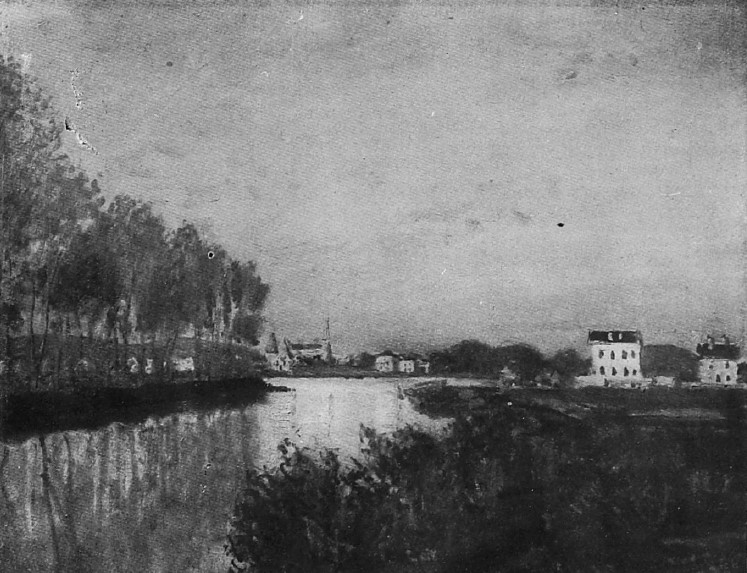
LA SEINE A ARGENTEUIL
that time in London, about a young painter that he would like to pre sent to him, and added that if Du rand – Rucl would buy some of this young artist’s pic tures, he (Dau bigny) would take them in payment for his own works. This young painter was Monet. When the artist appeared with six canvases la mer sauvaoe under his arm, By ctaudc Monet Durand-Ruel pur- chased two or three, and Monet then made him acquainted with Pissarro and Sisley. This was the active beginning of the Durand-Ruel interest in the im pressionistic group. Alfred Stevens had, however, previously in 1864, called Durand- Rucl’s attention to some features of the coming school. During the visit in London, the sub ject of our sketch was charmed with the atmospheric effects o
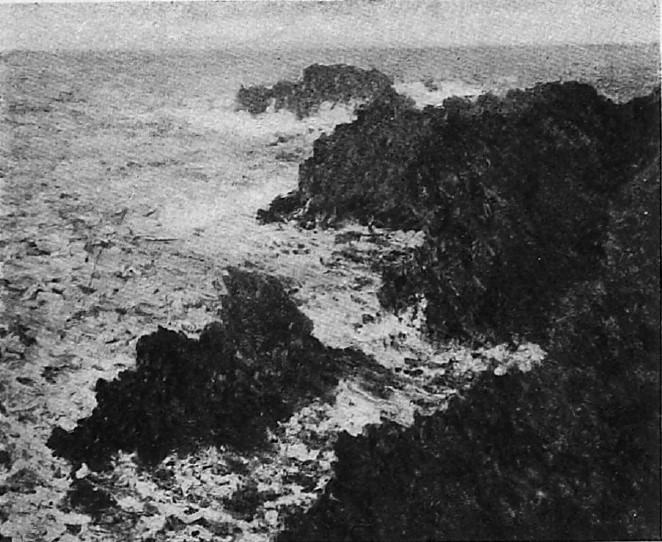
LA MER SAUVAGE
f fogs on the Thames, but it was not until nearly thirty years later that he was enabled to begin a series of pictures illustrating their beauty. In the autumn of 1899, Monet went to Lon don and began his studies, following the visit by one seine, giverny the spring of 19ОО and for three years afterwards, in each of which years he spent about three months in that capital. The result is that Monet has undoubtedly painted more than one hundred different canvases in cpnnection with the “Thames Series,” destroying, combining, ever striving after those illusive, misty phantoms which pur
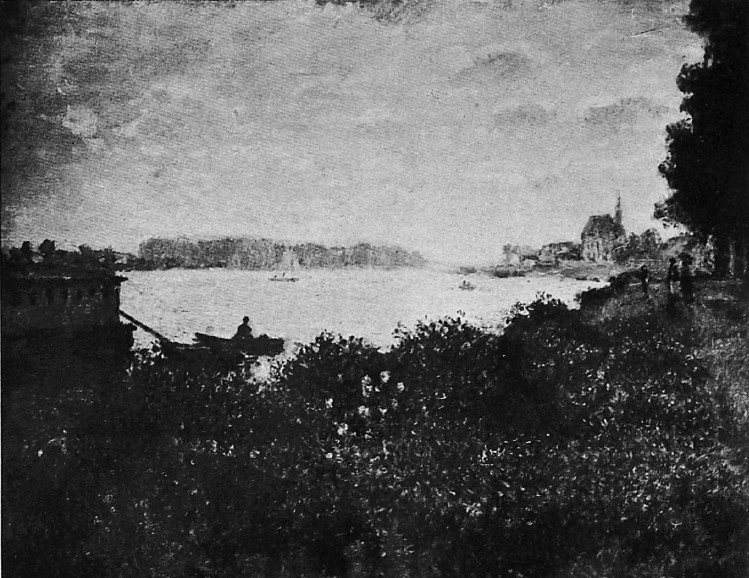
LA SEINE A ARGENTEUIL
sue each other with relentless haste out of the half lights and vapors of the river. As far as the writer knows there are thirty- seven of the Thames pictures; they are really more of a studio series than any of the other works of the master. The original studies were, of course, all made from nature, but the final result has been achieved in the studio, so the works will probably be known as a Studio Series. Another very beautiful set of the “series” pictures, was what is known as ‘‘ Les Glacons, ’ ’ floating ice on the Seine. They were painted about 1880. One of the best is now owned in New York. It is a large canvas about five feet in length, of wonderful fidelity to nature, soft and mysterious, and bathed in gray effects. The writer finds among his notes a sketch of this picture made in 1889 on a sheet of paper attached to the Monet-Rodin exhibition of that year, and accompanied by several endearing epithets. Then there are the “Falaises,” or “Cliff Series,’’ the “Belle-Isle,” “Dieppe,” etc.; but it is useless to pursue this matter further.

LES CHAMPS DE TULIPES
consideration of all these remarkable subjects will, however, convince the conscientious student that no other landscape artist has surpassed Monet in the richness and variety of the problems which he has attacked in his active career. This is but a manifestation of his great love of all the variations in the moods of nature herself, con stituting one of the peculiar characteristics of his work. He is of too large a nature to rest content with maturing a single line of effects. He constantly seeks new worlds, to conquer and nothing seems too difficult for his technique to accomplish. If we may not admire all of his painting, we must admit its intellectual supremacy. The “Thames Series’’ is divided into three groups, one known as the “Waterloo Bridge,” another as the 4 ‘Charing Cross,” and the third the “Houses of Parliament’* group. The Waterloo is a masonry arched bridge for highway traffic, while the Charing Сrow Bridge may be easily distin- guished by a straight iron girder bridge, which car- ries a railway.
They are all so rauir misty, that at firs* the beholder gates with astonishment at what seems to be a half-finished picture; but gradually as the eye penetrates the fog, objects begin to come out. one by one, just as in reality they dominate the fog. The illusion is wonderful, and has never been at tempted in exactly the tame manner before. The Houses of Parlia ment shine out of the fog with the color of o&d rose or purple. Probably no pa per on Monet would be considered ас all comprehensive without an allusion to the life Ы the artist. Biographies are expressions of stuped details, but an effort must be made briefly to career. His father was a mcrphant, living in Havre during the greater part of Monet’s youth, but the artist was born In Paris, on November 14. 1&40. We have the usual blanketing of youthful aspirations on the part of the head of the house, and Monet was no exception to the long 1»U who have had to follow the bent of their inclina- tions without family aid. He began as a caricaturist, and a such gained a reputation in Havre, where his productions were hung in a window alongside of Boudin’s silvery landscapes. Boudin was an older man, then unknown to fame, but he was still producing the same canvases which are now eagerly sought for in two conti- ents.
It was Boudin who first turned Monet’s thoughts to the beauties of the sea and ky, the animals, and the purple of the land- scape , and the everlasting hills. Six months in his company convinced Monet that he wished to become a painter, and with one thousand franca In his pockets, the savings from his caricature pictures, he started at sixteen years of age for Paris. Here Troyon tried to persuade him to enter the studio of Couture, but to no purpose, then came the meeting with Pissarro, who was “tranquilly working in Corot’s style.” Monet followed, but for the four years, during which he visited Havre frequently, he was governed by Boudin, although always painting on broader lines. Then followed the two years in the army in Algiers, the severe sickness, the convalescence at home, the compromise with his father, and the entrance Into the classical studio of Charles Gabriel Gleyre, where he made the acquaintance of Renoir and Sisley. Then followed the rebellion against the teachings of the studio and the secession. Baxille and Monet took a studio together. The former was a man of talent, but died too eoriy for ripened fruit; then Monet came under Jongkind’s influence, that poet artist, wlocuork are only now beginning to be appreciated by the world at large, at anything like their true value. Three years later Monet exhibited. Two marine pictures were highly praised and hung on the line. In the “Woman in Green” was exhibited and praised. Monet’s path was rapidly leading to success, when he suddenly left the road, throwing himself heart and soul into the puin-air movement. We arrive now at a most important turning-point in the world of art.
”Plitt-dir” was under discussion in the studio and the caf Monet was perhaps the first real innovator, but others were wrestling with the problems of the separation of colors, the subdivision of tones, the effects of light, and the desire to surround the woods and water with their true atmospheric conditions. Several scientific men were at the ume time promulgating the results of their researches into the laws of the juxtaposition of colors, and their reciprocal effects. Monet tried to put upon the canvas the emotions of the mind as fed by the eye. but found that no method of mixing translated the soft and luminous effects of nature, for the reason that the mixing on the palette only produced a dead nature, not one filled with the sun’s rays. Turner had before been working with prismatic colors, and to London some of the diligent students of the Cafc Guerbocs repaired, and there they received encouragement to continue their researches in the new field which they were opening on the other side of the channel. Xfanet has perhaps beer, wrongly introduced into this group. He died before he could-realize the importance of the steps in which he was beginning to be interested. We know all about the history that followed; the different work of the same school as carried on by Degas, Pissarro, Sisley, Сёгаппе, Renoir, and all the rest, and the struggles that each made in his own way and guided by his own individuality; but of them all Monet has never swerved from the straight road, which was entered in 1865, but has gone on with patience and courage through the succeeding years, his powers ripen- ing, his style broadening until he has lived to see the influence of the plein-air movement felt in all the world of art. So great is this influ- ence that although many artists deny its power, they yet are uncon- sciously influenced, even though they are not willing to testify as to its character. This will be readily understood by comparing the work of these very artists painted before and after the advent of the plein-air or impressionistic movement. It will be found that the key has been raised, the lights are brighter, the skies more luminous, and the shadows bluer. Perhaps no artist has been more maltreated by critics and by the public, until within a few years, than has Monet. He has known what it is to have the iron enter his soul, to be misunderstood by his fellowmen, and ridiculed by his brother painters. Small coins have been heaped upon his frames in de rision, and his can vases refused and returned, but there were a few who ap preciated and val ued the experi mental researches of the artist in those early days. Such critics as Burty, Mirbeau, Castag nary, Chesneau, and Duranty, and men of letters like Dau det and D’Hervilly and Zola, and col lectors like Faurc, Charpentier, D’Au riac Etienn Bau dry, de Belio, and Choquet, all recognized his manifest abilities. In 1886 Durand-Ruel, whose name has been indissolubly linked with the fortunes of the impressionists, just as it was before with the Romanticists, had his first exhibition of Monet’s work in New York under the management of the American Art Association. There were forty-one Monets in this exhibition. Another followed the same year at the National Academy of Design, and in 1887, May 25th, June 30th, twelve Monets were exhibited among “celebrated paint ings brought from Paris.” In all of this work Mr. James F. Sutton took an active interest, with the result that he is to-day probably the owner of more Monets than any one individual collector, with the exception of Durand-Ruel, and he is certainly one of the most appre ciative of the Monet admirers. In March, 1891, an exhibition of Monets, Pissarros, and Sisleys was held at Chase’s Galleries, Hamil ton Place, Boston, and in the year 1892 the St. Botolph Club of Boston gave what was probably the first exhibition in
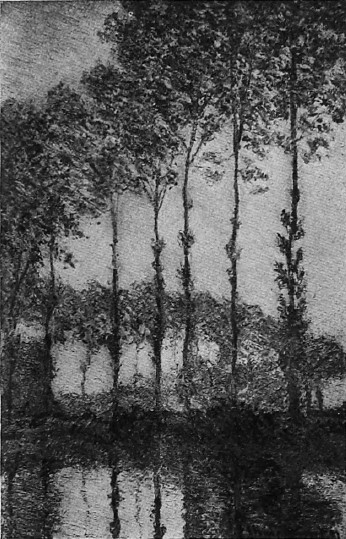
PEUPLIERS
this country entirely devoted to the works of Monet. There were twenty one pictures, and several thousand Bos- ton people flocked to the exhibition. It was certain ly interesting to listen to the remarks which were made at that time, but many continued to ponder and study, and now there are nowhere in the world more devoted admirers of the works of Monet than are found in this puritan city of New England. There are thirty of his pic tures now in Boston, and comparatively few are in the hands of one person. Twenty-two Monets were shown at the Lotus Club in New York, in January, 1899. Monet exhibits on the other side of the water were chiefly held in 1874, 1876, 1877, 1879, and 1882. Later, in 1889, there was a magnificent collection of about one hundred and fifty of his works shown in Paris, at the Georges Petit Gallery, in connection with sculptures by Rodin. The writer had the good fortune to visit this exhibition many times, and although practically deserted by the great world which flocked to the main exhibition, there were not a few on whom the interesting works made a lasting impression. These pictures covered the period 1864-1889. They are now well scattered. Many of them are now in this country, and some of them may be seen in the present Copley Hall Collection. It may not be generally known that as early as 1883-1884, Dowdeswell had an exhibition of Monet’s works in London. A word as to the meaning of the word “Impressionism.” This is a term which has been applied by the public to the plein-air school, and not one that they liked or adopted. At the Salon of rejected painters in 1873, Monet exhibited a picture entitled “Impressions of a Setting Sun.” and it was the Charivari, a comic newspaper which that year referred to the little group of painters as “Impressionists.”
The title has clung to them ever since. It was not so much the desire to give a rapid impression of the passing phases of nature that actuated the group, as it was to get the effects of light, the true values of tones, and the real life instead of thodead image of nature. From the charming and delicate effects at Argcnteuil to the masterful renderings of the cliffs at Etrctat, from the tulip gardens of Holland to the rugged mountains of Norway, with their white heads battling the storms of snow and ice, we have in Monet the great and steadfast revolutionary from all the precepts of landscape art that preceded him. We have not only the daring innovator, but we have a patient and devoted slave of nature who has faithfully striven to portray her effects as he sees them. But success, as measured in this world, has come to him as a happy incident, which arrives simply in anticipation of what would inevitably have arrived after the artist’s death, as it too often comes to the great majority of artists when they are no longer living to enjoy the fruits of their labors. With a large income and surrounded by every comfort.
Monet still pursues, with matured vision, the same studies which have for so many years occupied his thoughts. That he will be regarded in the future among the greatest of the landscape artists seems already well assured, for his great technical skill and his wonderful capacity for receiving and interpreting the impressions of nature are admired by a constantly increasing circle of amateurs and critics. It is this constancy to the highest source of art education and inspiration which gives him those high qualities for which he is justly distin- guished. He lives in an atmosphere almost of his own creation, surrounded by the beauties of nature in a country to which his followers now repair, as did the admirers of Corot and Millet. His eyes arc constantly refreshed by the remarkable colors and beauties of his beloved flowers, and his busy hand still reaches out for new fields of inspiration and effort.




